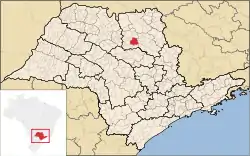Jaboticabal | |
|---|---|
 Flag  Coat of arms | |
 Location in São Paulo state | |
 Jaboticabal Location in Brazil | |
| Coordinates: 21°15′17″S 48°19′20″W / 21.25472°S 48.32222°W / -21.25472; -48.32222 | |
| Country | Brazil |
| Region | Southeast |
| State | São Paulo |
| Mesoregion | Ribeirão Preto |
| Microregion | Jaboticabal |
| Government | |
| • Mayor | José Carlos Hori |
| Area | |
| • Total | 707 km2 (273 sq mi) |
| Elevation | 605 m (1,985 ft) |
| Population (2020 [1]) | |
| • Total | 77,652 |
| • Density | 110/km2 (280/sq mi) |
| Time zone | UTC-03:00 (BRT) |
| • Summer (DST) | UTC-02:00 (BRST) |
| Website | Official website |
Jaboticabal is a municipality in the state of São Paulo in Brazil. The population is 77,652 (2020 est.) in an area of 707 km².[2] The town takes its name from the jabuticaba tree.
Jaboticabal is home to the UNESP university campus, and is also the city that produces the most peanuts in Brazil. Around the city are extensive sugar cane plantations and industries making Jaboticabal one of the most important cities in agrobusiness around its region.
Economy
The municipality is located in one of the richest regions in São Paulo State, SE Brasil, responsible for approximately 8.5% of its gross domestic product (GDP).
References
Capital: São Paulo | |||||||||||||||||||||
|  | ||||||||||||||||||||
| |||||||||||||||||||||
| |||||||||||||||||||||
| |||||||||||||||||||||
| |||||||||||||||||||||
| |||||||||||||||||||||
| |||||||||||||||||||||
| |||||||||||||||||||||
| |||||||||||||||||||||
| |||||||||||||||||||||
| |||||||||||||||||||||
| |||||||||||||||||||||
| |||||||||||||||||||||
| |||||||||||||||||||||
This article is issued from Wikipedia. The text is licensed under Creative Commons - Attribution - Sharealike. Additional terms may apply for the media files.